Editor of this issue: Antanas Klimas, University of Rochester
Copyright © 1994 LITUANUS Foundation, Inc.

|
LITUANUS
LITHUANIAN QUARTERLY JOURNAL OF ARTS AND SCIENCES
Volume 40,
No.1 - Spring 1994
Editor of this issue: Antanas Klimas, University of Rochester ISSN 0024-5089
Copyright © 1994 LITUANUS Foundation, Inc. |

|
ANTANAS TAMOĐAITIS
Antanas Tamođaitis was born in Lithuania in 1906. In 1929 he graduated from the Kaunas School of Art and remained to lecture there for the next two years. From 1931 to 1940 he served in the Chamber of Agriculture as director of the folk art and domestic industry section and traveled throughout the country, studying folk weavings and their techniques. During this time he published thirteen studies on Lithuanian folk art. In 1936 he had his first exhibition of tapestries in the Cultural Museum in Kaunas. Tamođaitis has won gold medals for his tapestries at the international expositions in Paris (1937), Berlin (1938), and New York (1939).
After World War II he lived in Germany. From 1946 to 1949 he lectured at the Ecole des Arts et Metiers in Freiburg. In 1949 he arrived in Canada, settling in Montreal. For a year he was the director of the Academy of Arts and Crafts at the local Y.M.C.A. In 1950 he established his home and studio near Kingston, Ontario, and devoted himself entirely to his art. In 1989 he moved to Ganaoque, Ontario.
Tamođaitis participated in many group shows in France, Germany, Canada, Venezuela, Colombia, and the United States, and had one-person shows: in Montreal (1949, 1971), Chicago (1962, 1963), Philadelphia (1964, 1980), Ottawa, Ontario (1964, 1965, 1966), Kingston, Ontario (1965, 1984), Detroit (1966, 1984), Toronto (1967, 1976), Sarnia, Ontario (1968), Windsor, Ontario (1969), Washington, D.C. (1970), Boston (1971), Brampton, Ontario (1982), Mississauga, Ontario (1974, 1981), Winnipeg, Massachusetts (1974), Hamilton, Ontario (1975), Brooklyn, New York (1981), Chicago (1986).
Tamođaitis authored several volumes on Lithuanian folk art, including Lithuanian Easter Eggs (Toronto, 1982), and co-authored with Anastazija Tamođaitis (Tamođaitienë) Lithuanian National Costume (Toronto, 1979) and Lithuanian Sashes (Toronto, 1986).
Tamođaitis works in oils, lithographs, and watercolors. Over the years he has developed a highly personal style based on a synthesis of modern abstract elements and Lithuanian folk art motifs. In most of his recent pictures he uses a very distinct compositional framework reminiscent of frost patterns on a window pane, by which his work can immediately be recognized. On this intricately woven framework he paints figures and subjects found in Lithuanian folk tales, legends, or plastic art.
He and his wife, Anastazija, are considered the chief champions of the cause of Lithuanian folk art. Throughout their lives they worked hard collecting, conceptualizing, and advocating the esthetics of artifacts made by the simple craftsmen of the Lithuanian countryside. They wrote about them, published monographs about them, and incorporated their findings into their own art work. The fact that they were uprooted and removed from the source of their inspiration—their homeland, the towns and villages where much of this primitive art was created—did not diminish their zeal and devotion.
Because of his immersion in the ethnographic dimension of Lithuanian art history, Tamođaitis' work is best characterized by its association with the best elements of Lithuanian folk art, from which his themes and images are derived. The vibrant coloration of Tamođaitis' paintings is that of the sashes of the village weaver, who has learned how to extract the coloring fluids from home-grown plants and flowers. The plasticity of his figurines is modeled according to the naive lines and shapes perfected by the village carver. Even the two-dimensionality of his "frosted" lines in relation to their background reminds one of the lack of depth in the homemade tapestries woven by farm women. For someone else, one who is less familiar with the traditions of genuine folk art, following their rules would probably pose the risk of becoming a copycat. Tamođaitis seems to be "at ease" here, mainly because he has managed to identify himself with the traditions he is following.
Tamođaitis is also one with nature. The "weaving" patterns of his frosted line motifs approximate the natural growth of a vine or a branch. Here the symmetry of a perfect geometric pattern gives way to the chaotic paths of twisting twigs or running rain water. The false moves in growth remain uncultured. These elements, no doubt, have been derived also from his lifestyle as an outdoor person, preferring to live and work in countryside surroundings rather than in city-like dwellings.
Algimantas Kezys
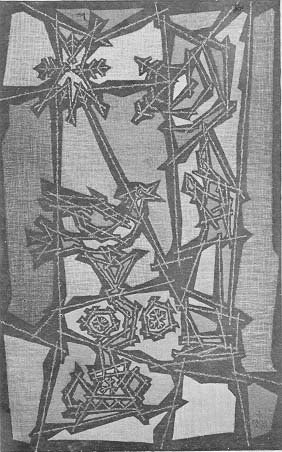
Folk Legend, c. 1967, oil
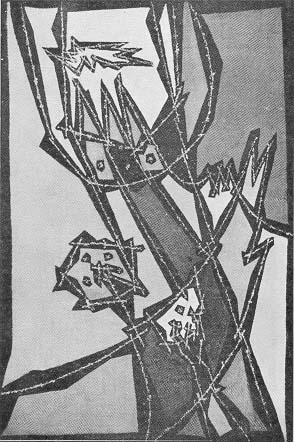
Serenade, c. 1969, oil
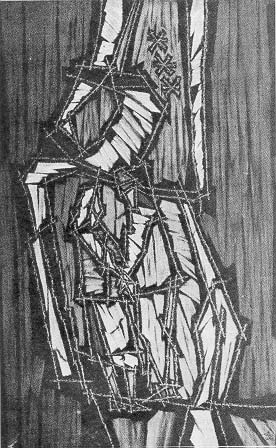
Friendship, c. 1970, oil
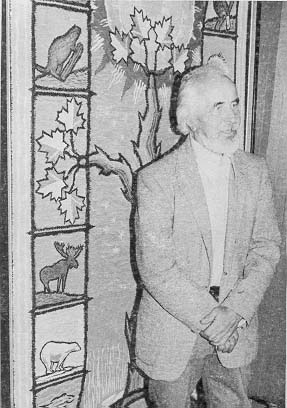
Antanas Tamođaitis
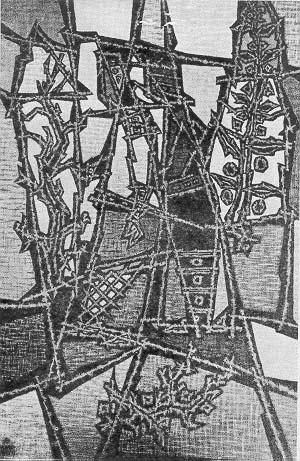
Walk, c. 1970, oil
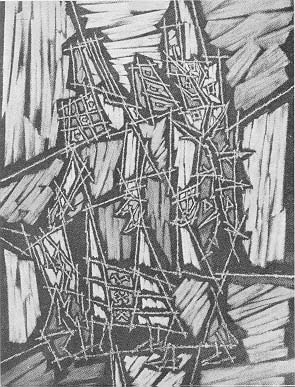
Promenade, c. 1969, oil
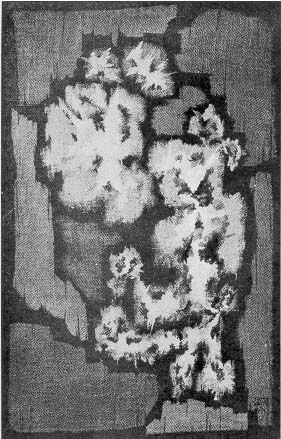
Variation, c. 1969, oil
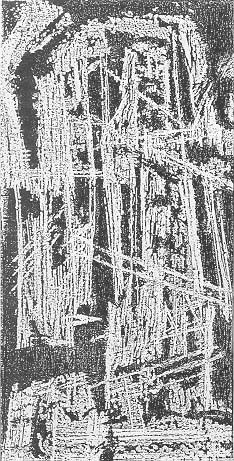
Pensive Christ, 1981, lithograph

Ex Libris by Antanas Tamođaitis